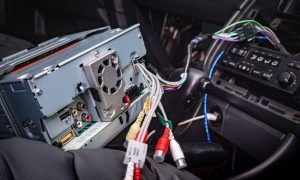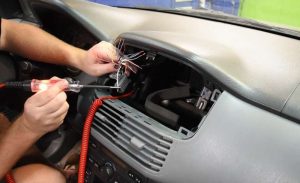Bypassing your alternator’s voltage regulator is a risky procedure that should only be considered as a last resort for troubleshooting purposes. It’s crucial to understand the potential dangers and long-term consequences before attempting this. This guide provides a step-by-step process, but it’s strongly recommended to seek professional help if you’re not comfortable working with automotive electrical systems. Incorrectly bypassing the regulator can damage your alternator, battery, and other vehicle components.
Contents
- Understanding Your Alternator’s Voltage Regulator
- Identifying the Voltage Regulator’s Location
- Assessing the Risks of Bypassing the Regulator
- Necessary Tools and Safety Precautions
- Disconnecting the Voltage Regulator Wiring
- Bypassing the Regulator: A Step-by-Step Guide
- Testing the Alternator Output Voltage
- Potential Problems After Bypassing
- Long-Term Effects and Considerations
- Alternative Solutions to Voltage Issues
Understanding Your Alternator’s Voltage Regulator
The voltage regulator is a crucial component within your alternator. Its primary function is to maintain a consistent and safe output voltage, typically around 13.5-14.5 volts. Without it, the alternator could overcharge your battery, leading to damage or even explosion. The regulator achieves this by controlling the alternator’s field current, which directly impacts the amount of electricity generated. It acts as a feedback loop, constantly monitoring the battery voltage and adjusting the alternator’s output accordingly.
Understanding how the regulator works is paramount before considering bypassing it. A malfunctioning regulator can lead to undercharging (causing a dead battery) or overcharging (damaging the battery and other electrical components). Bypassing the regulator eliminates this control mechanism, leaving the alternator’s output unregulated and potentially damaging.
Identifying the Voltage Regulator’s Location
The location of the voltage regulator varies significantly depending on the vehicle’s make, model, and year. In some vehicles, the regulator is an internal component within the alternator itself, meaning it cannot be bypassed externally. In others, it’s a separate unit mounted on the alternator or even located elsewhere in the vehicle’s electrical system.
Consult your vehicle’s repair manual or an online resource specific to your car’s model to pinpoint the voltage regulator’s exact location. Carefully examine the alternator and its surrounding components. The regulator might be identifiable by its small size and multiple wire connections. If you’re unsure, it’s best to avoid attempting this procedure.
Assessing the Risks of Bypassing the Regulator
Bypassing the voltage regulator removes the critical safety mechanism that prevents overcharging. This can lead to significant damage to your battery, including boiling of the electrolyte, warping of the plates, and ultimately, battery failure. Furthermore, overcharging can damage other sensitive electrical components in your vehicle, potentially leading to expensive repairs.
Beyond battery damage, an unregulated alternator can produce excessively high voltage spikes that can fry electronic control modules (ECMs), alternators themselves, and other sensitive electrical parts. The risk of fire is also significantly increased due to the potential for overheating and short circuits caused by excessive voltage.
Necessary Tools and Safety Precautions
Before attempting to bypass the voltage regulator, gather the necessary tools. This typically includes a multimeter to test voltage, wire cutters/strippers, crimp connectors, and possibly a soldering iron (depending on your approach). Always disconnect the negative battery terminal before beginning any work on the vehicle’s electrical system.
Safety is paramount. Wear appropriate safety glasses to protect your eyes from sparks or flying debris. Ensure the vehicle is parked on a level surface and the parking brake is engaged. Never work on the electrical system while the engine is running. If you are uncomfortable with any aspect of this process, seek professional assistance.
Disconnecting the Voltage Regulator Wiring
The method for disconnecting the voltage regulator wiring depends on whether it’s an internal or external unit. For an external regulator, you’ll need to carefully disconnect the wires leading to it. Take note of which wire goes where – a diagram or photograph will be invaluable. For an internal regulator, bypassing it requires more advanced techniques, often involving internal modifications to the alternator itself.
Disconnect the wires one at a time, labeling them clearly to avoid confusion during reconnection. Use a multimeter to confirm that power is removed from the regulator before proceeding. If you are unsure about any connection, consult a wiring diagram or seek professional help. Improper disconnection can lead to short circuits and damage to your vehicle’s electrical system.
Bypassing the Regulator: A Step-by-Step Guide
This guide assumes an external regulator. The exact steps will vary depending on the vehicle and regulator design. Typically, you’ll need to identify the field wire (often thinner than the others) and the battery sense wire. Connect the field wire directly to the battery positive terminal. This bypasses the regulator’s control over the field current.
This is extremely risky and should only be done for temporary diagnostic purposes. Monitor the alternator’s output voltage closely using a multimeter. If the voltage is excessively high, immediately disconnect the wire and seek professional assistance. Remember, this is a temporary solution, and the alternator should not be run for extended periods in this configuration.
Testing the Alternator Output Voltage
After bypassing the regulator (if possible and only temporarily), use a multimeter to measure the alternator’s output voltage. Connect the multimeter’s probes to the battery terminals with the engine running. The voltage should be around 13.5-14.5 volts. If it’s significantly higher, this indicates the alternator is overcharging and the bypass should be immediately disconnected.
If the voltage is lower than expected, it could indicate a problem with the alternator itself, not just the regulator. In either case, the bypass should be removed, and the problem should be addressed correctly, ideally by a qualified mechanic. Do not leave the regulator bypassed for extended periods.
Potential Problems After Bypassing
Even if the alternator seems to function correctly after bypassing the regulator, several problems can arise. The most prominent is overcharging, which can damage your battery and other electrical components. This can lead to premature battery failure, requiring expensive replacement. Other electrical components, such as the ECM, can also be damaged by excessive voltage.
Another potential problem is inconsistent voltage output. Without the regulator’s control, the alternator’s output might fluctuate wildly, leading to erratic behavior in your vehicle’s electrical system. This could manifest as flickering lights, intermittent power failures, or even complete system shutdowns.
Long-Term Effects and Considerations
Running your vehicle with a bypassed voltage regulator for extended periods is highly discouraged. The long-term effects can be catastrophic. Continuous overcharging will severely damage your battery, potentially leading to its complete failure. This can strand you and cause significant inconvenience.
Furthermore, the risk of fire significantly increases due to the potential for overheating and short circuits. The damage to other electrical components can be extensive and expensive to repair. It’s far more cost-effective and safer to repair or replace the voltage regulator than to deal with the consequences of bypassing it.
Alternative Solutions to Voltage Issues
Before considering bypassing the voltage regulator, explore alternative solutions. A faulty voltage regulator is the most common cause of charging problems. Replacing the regulator is a far safer and more effective solution. If the problem persists after replacing the regulator, the alternator itself might be faulty and require replacement.
Consider having a qualified mechanic diagnose the problem. They can accurately identify the root cause and recommend the appropriate repair or replacement. This approach is far safer and less likely to cause further damage to your vehicle’s electrical system than attempting a bypass.
Bypassing your alternator’s voltage regulator is a dangerous procedure with potentially severe consequences. While this guide outlines the steps, it strongly emphasizes the risks involved. It’s crucial to prioritize safety and consider professional help. Repairing or replacing the voltage regulator is always the recommended approach to resolving charging issues. Never operate your vehicle for extended periods with a bypassed regulator.






